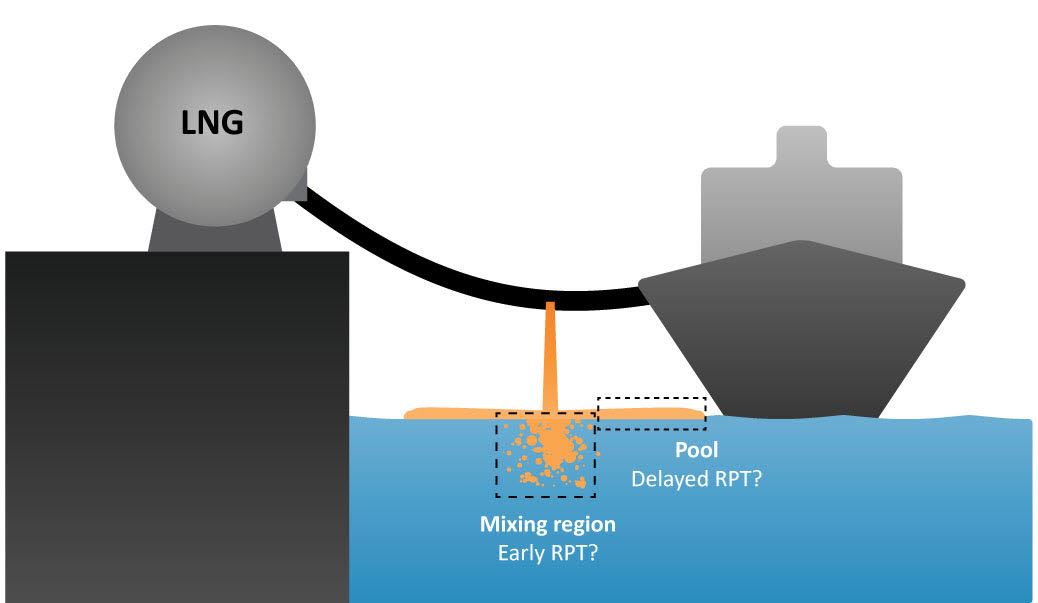It is often necessary to transfer LNG in loading arms and lines directly above the sea. Examples include refuelling of LNG-driven ships and passenger ferries and loading and un-loading of LNG-carriers at liquefaction plants and LNG terminals. During these operations, LNG may accidentally be spilt onto the sea. The water will be at least 160 degrees C warmer than the LNG. When RPT is triggered, the LNG is quickly heated due to the large temperature difference. The quick heating rate causes the LNG to overheat, and in some cases the degree of overheat in the LNG will be so large that it can no longer exist as a liquid. At this point, large volumes of the LNG may instantaneously vaporize, thereby creating a local overpressure. The expansion that follows is a physical explosion that may cause harm to personnel and equipment.
Although historically the number of RPT accidents has been relatively low, large-scale experiments have demonstrated that RPT explosions can occur during LNG spills under industrially relevant conditions. The increased use of LNG, for example in commercial transport vessels, can lead to more incidents as well as a higher risk of injuries and loss of life. It is therefore important to understand the RPT phenomenon during LNG spills on water.
In Predict-RPT, we focus on the evolution of an LNG spill from initiation to superheating conditions, on the physical mechanisms that trigger the RPT event, and on the subsequent rapid phase transition. We have established a simulation framework for delayed RPTs that combines state-of-the-art CFD, heat-transfer models and thermodynamics, utilizing accurate thermodynamic data for hydrocarbon mixtures from a SINTEFs in-house library.
As a part of the project, the framework has been given three major improvements; a new, simplified, model for spreading of LNG on water has been derived, the suitable approximation for the superheat limit of the LNG has been identified, and a best-fit heat transfer model has been selected.
The superheat limit is an important parameter for predicting the overpressure caused by the rapid evaporation. In Predict-RPT, we have shown that for single- and multi-component fluids, the classic nucleation theory provides estimates for the superheat limit of LNG that agree well with experimental data. This is incorporated in our model for predicting the potential energy yield in an RPT event.
The simplified CFD model for the spreading of LNG on water has been validated by comparisons both with a more complex two-layer pool spreading model and with experimental results from the literature. Several sets of heat transfer correlations have been evaluated and the set with the best agreement with existing experimental data has been implemented into the framework.
A simplified tool for assessment of the risk and consequences of LNG RPT has been developed through a combined usage of the modelling framework and theory. The tool evaluates key parameters such as risk zone for RPT, mass and energy of RPT in risk zone, and duration until risk state is reached. It is able to predict how these parameters depend upon spilled volume of LNG. The tool can also predict the overpressure in the case of a rapid phase transition event.
The advances made in the project are documented in eight published journal papers, of which six stems from the work undertaken by the PhD. A final paper which presents the modelling framework and the simplified model for assessing RPT events from LNG spills is ready for submission to journal. Project results have also been presented at SIGTTO events in Oslo and Houston.
The PhD student (NTNU) defended his thesis in March 2019. The thesis included a 130-page monograph summarizing the research, as well as six peer reviewed journal articles that have all been accepted and published since. The PhD student has also presented results at three academic conferences. The most significant academic work was performed while staying in Chicago as a Fulbright Scholar at Northwestern University, working with Professor Stephen H. Davis, a highly renowned expert in fluid mechanics. The most novel result was published in Journal of Fluid Mechanics, arguably the world’s most prestigious journal in the field. His work includes investigations of the stability of the film isolating LNG droplet from direct contact with water, the development of a theoretical prediction of the Leidenfrost temperature, the derivation of non-equilibrium evaporation models from kinetic theory and a simplified model for triggering of delayed RPT and consequent vapour explosion.


